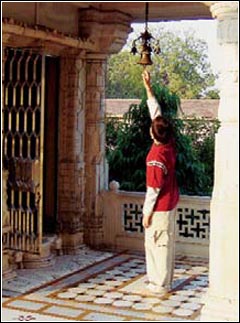Udupi; Dec 03: It is believed that deities remain manifest in mandirs in which bells (ghanta) are rung. In Hindu mandirs, bells are usually hung in the area or porch preceding the inner sanctum. Devotees ring them as an invocation to the deity to listen to their prãrthnã and be blessed. Young children love to jump up and ring the bell. Such samskãras of childhood remain during adulthood.
The bell is rung prior to ãrti to inform devotees to rush for ãrti’s darshan. During ãrti the bell’s auspicious (maangalik) sound wards off evil. When rung with a tuned rhythm, the bell’s maangalik sound (naad) has the power to focus the wandering and hyperactive mind on the deity and sentiments of the ãrti’s lyrics.
During artis, the bell’s sound has the effect of spiritually boosting a person in the morning and relieving the day’s mãyic stress in the evening. In India, bells can be heard ringing in the morning (shangãr) and evening (sandhyã) artis, in every city, town and village. This collectively, spiritually energises the immediate vicinity of a shrine.
The ringing bell ineffably attracts people’s attention. If they happen to pass by a shrine during ãrti, regardless of whether the deity is their Ishtadeva or not, they devotionally offer a slight bow or place their right hand on their chest or offer pranãms. Such is the devotional reverence (bhãvnã), inherent in the hearts of Hindus.
Unique sound and symbolism of bells
There is an art and science of making bells to produce the requisite sounds. There are bells specially made to produce the long strains of the sound OM. The handle of a ghantadi signifies prãna – the vital force in the form of Hanumanji, Garud, Nandi or Chakra. During Garud sthãpanvidhi, the handle is offered pujan. A bell without a handle in one of these forms is forbidden in rituals, since it may augur misfortune. The body of the bell is said to represent the divinity of time.


